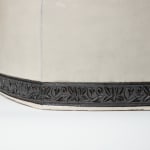Miwa Ryosaku 三輪龍作 b. 1940
H19.0 × Dia 31.7 cm
Exhibited: Shimonoseki Art Museum retrospective exhibition, 1994
Further images
-
(View a larger image of thumbnail 1
)

-
(View a larger image of thumbnail 2
)

-
(View a larger image of thumbnail 3
)

-
(View a larger image of thumbnail 4
)

-
(View a larger image of thumbnail 5
)

-
(View a larger image of thumbnail 6
)

-
(View a larger image of thumbnail 7
)

-
(View a larger image of thumbnail 8
)

-
(View a larger image of thumbnail 9
)

-
(View a larger image of thumbnail 10
)

-
(View a larger image of thumbnail 11
)

-
(View a larger image of thumbnail 12
)

-
(View a larger image of thumbnail 13
)

-
(View a larger image of thumbnail 14
)

Miwa Ryosaku (b. 1940) was born as the eldest son of the prestigious Miwa pottery family. The twelfth member of his family to hold the title “Kyusetsu 休雪,” the artist closely observed his father and uncle creating Hagi pottery from a young age, quickly becoming familiar with the style’s distinctive materials and techniques. He is also known as Miwa Kyusetsu XII, but to express his individuality as an artist and sculptor while maintaining his potter heritage, he assumed the name Miwa Ryosaku and published several artworks under this name to delineate between the professional identities of artist, sculptor, and potter. His younger brother is Miwa Kyusetsu XIII, who currently is at the helm for the Miwa Kyusetsu pottery lineage.
While Ryosaku uses the characteristic white tones of traditional Hagi glaze, which has been in use for twelve generations, he departs from tradition in both form and function, thus earning his reputation as a “Radical” artist. He was inspired by masters of Western modernity, particularly sculpture and painting which he admired. Miwa studied Goya and Soutine as a student in Tokyo and admired the powerful expressionism of painting.
This piece is made of the special river clay of the Hagi region, which fires into a warm deep brown that is akin to terracotta brown. Among his oeuvre, this vessel marks the transitional aspect between his work which is in constant flux. In other words, his transitional phasing between form and function. As a functional water jar with sculptural intent, the vessel shows an important part of Miwa Ryosaku’s expression, distilling his career that daringly walked the fine line of sculpture and vessel constantly. This particular piece was exhibited in a 1994 solo retrospective exhibition at the Shimonoseki City Art Museum, and is published in the exhibition catalog.













